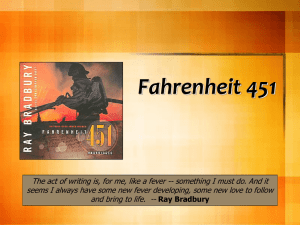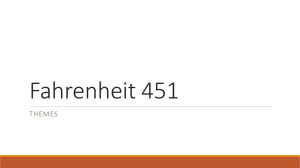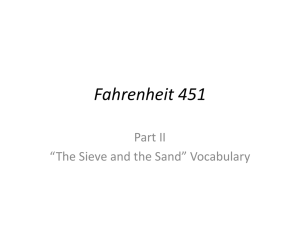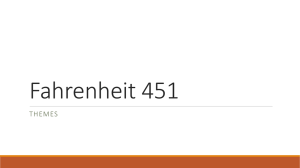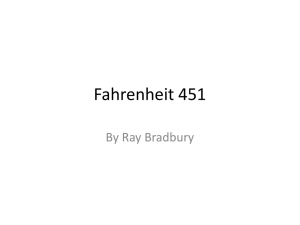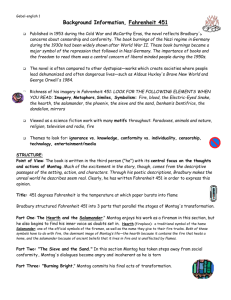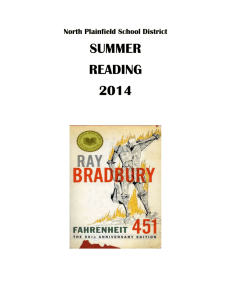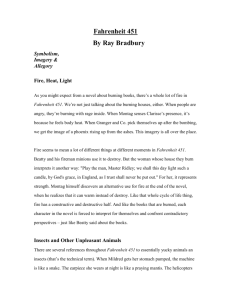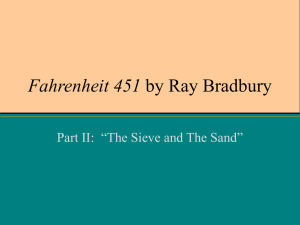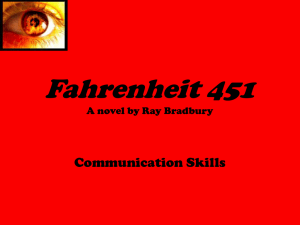Fahrenheit 451.theme powerpoint
advertisement
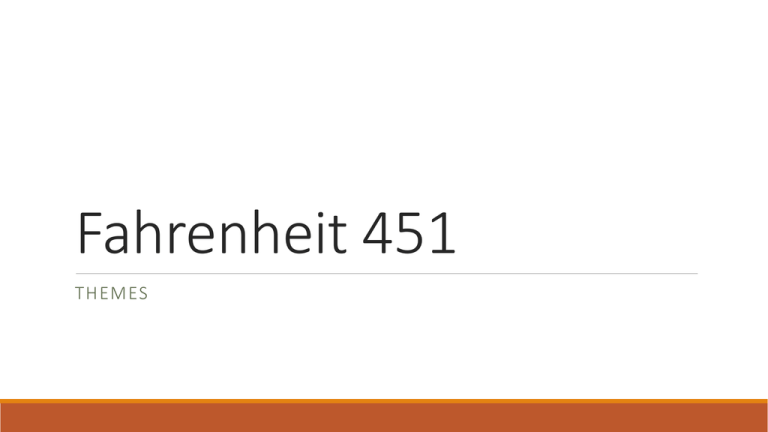
Fahrenheit 451 THEMES Censorship Books are banned in the society depicted in Fahrenheit 451.When they're found, they're burned, along with the homes of the books' owners. But it's important to remember that in the world of this novel, the suppression of books began as self-censorship. As Beatty explains to Montag, people didn't stop reading books because a tyrannical government forced them to stop. They stopped reading books gradually over time as the culture around them grew faster, shallower, intellectually blander, and centered around minor thrills and instant gratification. In such a culture, books became shorter, magazine and newspaper articles became simpler, cartoon pictures and television became more prevalent, and entertainment replaced reflection and debate. Action vs. Inaction In the years up to and before World War II, many societies, including Germany, become dangerous and intolerant. Even so, their citizens were afraid to speak out against these changes. Fahrenheit 451 was published in 1953, just a few years after WWII ended, and is very concerned with the idea of taking action versus standing by while society falters. In particular, the novel shows how Montag learns to take action, in contrast to Faber who is too cowardly to act. At the same time, Faber does help teach Montag the difference between reckless and intelligent action, so that by the end of the novel Montag is ready to act in a constructive rather than destructive way. TECHNOLOGY AND MODERNIZATION TV is the enemy in Fahrenheit 451. It’s responsible for replacing literature, intellectualism, and curiosity. On top of that, it’s become a substitute for family, friendship, and any sort of real conversation. The reason cited is "happiness." People are happier when they don’t have to think, or so the story goes. TV aside, technology is the government’s means of oppression, but also provides the renegade’s opportunity to subvert. RULES AND ORDER Fahrenheit 451 takes place in a world of strict rules and order. Books are illegal, free thought is essentially prohibited, and activities are tightly organized. What’s interesting is that much of the restrictions on the general populous are self-enforced. The government has taken away the citizens’ ability to dissent and veiled all dissatisfaction with a cheap version of "happiness." This means that little external regulation is required, as the citizens conform contentedly to the status quo. WISDOM AND KNOWLEDGE In Fahrenheit 451, wisdom and knowledge are gained through both experience and scholarship. Most important is critical thinking – challenging ideas rather than accepting them as absolutely correct. Mentors and teachers are integral to this process, not only for passing on knowledge but for opening the door to independent thought. VIOLENCE Excessive violence in the futuristic world of Fahrenheit 451 betrays a problematic underbelly to the status quo. Teenagers go around killing each other, TV is filled to the brim with violence, and even driving a car brings on the crazed thirst for speed and destruction. Violence is an outlet, and the cravings for such behavior mark the dissatisfaction of the general populous. IDENTITY The crisis of identity is at the core of Fahrenheit 451. As the main character learns from a series of mentors and teachers, he sees his own identity melding with that of his instructors. This is also a means of scapegoating – if your identity is not entirely your own, then you are not entirely responsible for your actions. The novel explores the question of how to define the self, and seems to answer: actions. DISSATISFACTION In the world of Fahrenheit 451, everyone seems to be happy. They watch TV all day, they never ask difficult questions, they’re never forced to face anything unpleasant, and they’re never truly bothered by anything. That being said, everyone is horribly dissatisfied. It’s just that no one is willing to admit it. The deep ennui that runs through the population is subdued by mindless activity and an insistence on happiness, both on the part of the government and the citizens themselves. MAN AND THE NATURAL WORLD Fahrenheit 451 creates a dichotomy between the world of technology and the world of nature. The former is cold and destructive, while the latter is engaging and informative. It is only in nature that the novel’s main character is able to think clearly and draw conclusions from his experiences. The novel argues that nature, in fact all of life, is a cycle of construction and destruction. This is the natural way of things, but technology has focused only on destruction and violence, leaving man in a devastating, unnatural state. Part 2: The Sieve and the Sand Review What happens to sand in a sieve? What does this have to do with Montag; what comparison does he make to the sand? How does Mildred react to Montag's reading? Why? Why does Montag think of the old man in the park? According to Faber, how has religion changed? Is it a good change? Why? How does Faber see himself and Montag? Part 2: The Sieve and the Sand Review What device does Faber give Montag so they can communicate? What feeling about the ladies does Bradbury communicate by his description of their conversation? Are they seen in a positive or negative way? How can you tell from the specific words he uses? When the women get together, what "fire images" does Bradbury use to describe the ladies? List at least five "fire" words that add to the imagery of the scene. Why does he do this, do you think? Why do you suppose the poem made Mrs. Phelps cry? What was Mrs. Bowles' reaction? Mildred's? Were you surprised that the Salamander stopped at Montag's house? What do you predict will happen next? Give two reasons from the text for your answer.
